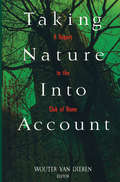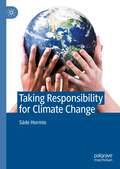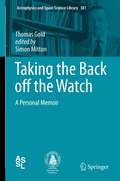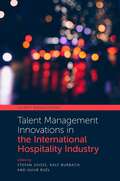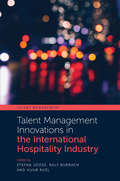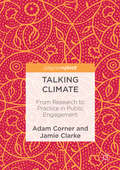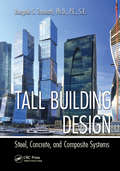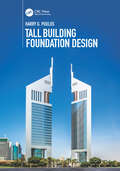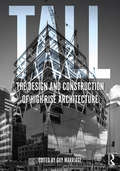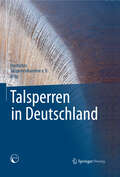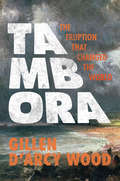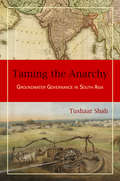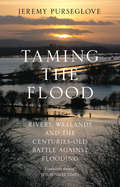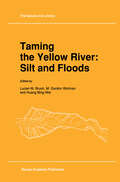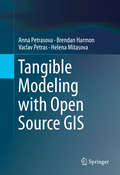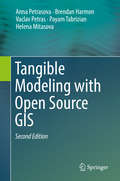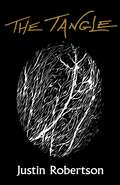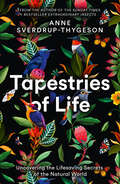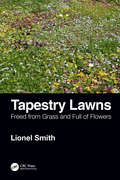- Table View
- List View
Taking Nature Into Account: A Report to the Club of Rome Toward a Sustainable National Income
by Wouter van DierenIndicators used to direct ecomonic policy are based on a number of factors - none of which, however, acknowledge the degradation of natural resources. Continued deterioration of the environment is leading us closer to crisis, while policymakers and the public base their decisions on dangerously incomplete information. In Taking Nature into Account, a number of the world's leading experts state the ethical, historical, economic, and ecological arguments for including environmental factors when measuring fiscal health. Initiated by the Club of Rome (an international group of influential businesspeople, statesmen, and scientists), and written in cooperation with the World Wide Fund for Nature, the report reviews existing methodologies and makes recommendations for adjusting the way we think about and measure the economy.
Taking Responsibility for Climate Change
by Säde HormioThis book proposes that it is not only states and international bodies that have a responsibility to take action toward mitigating climate change. Other collective agents, such as corporations, need to also come onboard. Additionally, the book argues that climate change is not solely a problem for collective agents, but also for individuals, as they are members of collectives and groups of several kinds. Therefore, framing climate change responsibility exclusively from either the collective or the individual perspective leaves out something crucial: how we all are influenced by the collectives we belong to and how, in turn, collectives are influenced by individuals. The focus of the book is on areas of climate change responsibility that are often left out of the picture or get too little attention in climate ethics, such as carbon inequality within countries. But why should any theoretical arguments about normative issues matter when we have a real-life climate crisis on our hands? Säde Hormio argues that ethical arguments have an important role in setting climate policy: they can highlight what values are at stake and help ground normative arguments in public deliberations.
Taking the Back off the Watch: A Personal Memoir (Astrophysics and Space Science Library #381)
by Thomas GoldThomas Gold (1920-2004) had a curious mind that liked to solve problems. He was one of the most remarkable astrophysicists in the second half of the twentieth century, and he attracted controversy throughout his career. Based on a full-length autobiography left behind by Thomas Gold, this book was edited by the astrophysicist and historian of science, Simon Mitton (University of Cambridge).The book is a retrospective on Gold’s remarkable life. He fled from Vienna in 1933, eventually settling in England and completing an engineering degree at Trinity College in Cambridge. During the war, he worked on naval radar research alongside Fred Hoyle and Hermann Bondi – which, in an unlikely chain of events, eventually led to his working with them on steady-state cosmology. In 1968, shortly after their discovery, he provided the explanation of pulsars as rotating neutron stars.In his final position at Cornell, he and his colleagues persuaded the US Defense Department to fund the conversion of the giant radio telescope at Arecibo in Puerto Rico into a superb instrument for radio astronomy. Gold’s interests covered physiology, astronomy, cosmology, geophysics, and engineering.Written in an intriguing style and with an equally intriguing foreword by Freeman Dyson, this book constitutes an important historical document, made accessible to all those interested in the history of science.
Talent Management Innovations in the International Hospitality Industry (Talent Management)
by Stefan Jooss Ralf Burbach Huub RuëlThe hospitality industry relies on the sourcing and development of talent to deliver excellent customer experiences and interactions in a 24/7 environment. Talent Management Innovations in the International Hospitality Industry explores both research and practical perspectives on contemporary talent management, presenting a diverse range of stakeholder views in a variety of international hospitality settings. This collection circumnavigates a wide range of subjects within the talent management field, including employer branding, creative talent, talent pools, and mentoring initiatives, along with a focus on talent identification, development, and retention. The new insights aid academics and professionals in gaining a greater understanding of the multifaceted nature of talent management in this people-centric industry and offers a comprehensive set of evidence-based research and practical examples of talent management innovation in the international hospitality industry.
Talent Management Innovations in the International Hospitality Industry (Talent Management)
by Stefan Jooss, Ralf Burbach, Huub RuëlThe hospitality industry relies on the sourcing and development of talent to deliver excellent customer experiences and interactions in a 24/7 environment. Talent Management Innovations in the International Hospitality Industry explores both research and practical perspectives on contemporary talent management, presenting a diverse range of stakeholder views in a variety of international hospitality settings. This collection circumnavigates a wide range of subjects within the talent management field, including employer branding, creative talent, talent pools, and mentoring initiatives, along with a focus on talent identification, development, and retention. The new insights aid academics and professionals in gaining a greater understanding of the multifaceted nature of talent management in this people-centric industry and offers a comprehensive set of evidence-based research and practical examples of talent management innovation in the international hospitality industry.
Talking Climate: From Research to Practice in Public Engagement
by Adam Corner Jamie ClarkeThis book describes a fresh approach to climate change communication: five core principles for public engagement that can propel climate change discourse out of the margins and into the mainstream. The question of how to communicate about climate change, and build public engagement in high-consuming, carbon-intensive Western nations, has occupied researchers, practitioners, and campaigners for more than two decades. During this time, limited progress has been made. Socially and culturally, climate change remains the preserve of a committed but narrow band of activists. Public engagement is stuck in second gear. By spanning the full width of the space between primary academic research and campaign strategies, this book will be relevant for academics, educators, campaigners, communicators and practitioners.
Tall Building Design: Steel, Concrete, and Composite Systems
by Bungale S. TaranathAddresses the Question Frequently Proposed to the Designer by Architects: "Can We Do This? Offering guidance on how to use code-based procedures while at the same time providing an understanding of why provisions are necessary, Tall Building Design: Steel, Concrete, and Composite Systems methodically explores the structural behavior of steel, concrete, and composite members and systems. This text establishes the notion that design is a creative process, and not just an execution of framing proposals. It cultivates imaginative approaches by presenting examples specifically related to essential building codes and standards. Tying together precision and accuracy—it also bridges the gap between two design approaches—one based on initiative skill and the other based on computer skill. The book explains loads and load combinations typically used in building design, explores methods for determining design wind loads using the provisions of ASCE 7-10, and examines wind tunnel procedures. It defines conceptual seismic design, as the avoidance or minimization of problems created by the effects of seismic excitation. It introduces the concept of performance-based design (PBD). It also addresses serviceability considerations, prediction of tall building motions, damping devices, seismic isolation, blast-resistant design, and progressive collapse. The final chapters explain gravity and lateral systems for steel, concrete, and composite buildings. The Book Also Considers: Preliminary analysis and design techniques The structural rehabilitation of seismically vulnerable steel and concrete buildings Design differences between code-sponsored approaches The concept of ductility trade-off for strength Tall Building Design: Steel, Concrete, and Composite Systems is a structural design guide and reference for practicing engineers and educators, as well as recent graduates entering the structural engineering profession. This text examines all major concrete, steel, and composite building systems, and uses the most up-to-date building codes.
Tall Building Design: Steel, Concrete, and Composite Systems
by Bungale S. TaranathAddresses the Question Frequently Proposed to the Designer by Architects: "Can We Do This? Offering guidance on how to use code-based procedures while at the same time providing an understanding of why provisions are necessary, Tall Building Design: Steel, Concrete, and Composite Systems methodically explores the structural behavior of steel, concrete, and composite members and systems. This text establishes the notion that design is a creative process, and not just an execution of framing proposals. It cultivates imaginative approaches by presenting examples specifically related to essential building codes and standards. Tying together precision and accuracy—it also bridges the gap between two design approaches—one based on initiative skill and the other based on computer skill. The book explains loads and load combinations typically used in building design, explores methods for determining design wind loads using the provisions of ASCE 7-10, and examines wind tunnel procedures. It defines conceptual seismic design, as the avoidance or minimization of problems created by the effects of seismic excitation. It introduces the concept of performance-based design (PBD). It also addresses serviceability considerations, prediction of tall building motions, damping devices, seismic isolation, blast-resistant design, and progressive collapse. The final chapters explain gravity and lateral systems for steel, concrete, and composite buildings. The Book Also Considers: Preliminary analysis and design techniques The structural rehabilitation of seismically vulnerable steel and concrete buildings Design differences between code-sponsored approaches The concept of ductility trade-off for strength Tall Building Design: Steel, Concrete, and Composite Systems is a structural design guide and reference for practicing engineers and educators, as well as recent graduates entering the structural engineering profession. This text examines all major concrete, steel, and composite building systems, and uses the most up-to-date building codes.
Tall Building Foundation Design
by Harry G. PoulosThis book provides a comprehensive guide to the design of foundations for tall buildings. After a general review of the characteristics of tall buildings, various foundation options are discussed followed by the general principles of foundation design as applied to tall buildings. Considerable attention is paid to the methods of assessment of the geotechnical design parameters, as this is a critical component of the design process. A detailed treatment is then given to foundation design for various conditions, including ultimate stability, serviceability, ground movements, dynamic loadings and seismic loadings. Basement wall design is also addressed. The last part of the book deals with pile load testing and foundation performance measurement, and finally, the description of a number of case histories. A feature of the book is the emphasis it places on the various stages of foundation design: preliminary, detailed and final, and the presentation of a number of relevant methods of design associated with each stage.
Tall Building Foundation Design
by Harry G. PoulosThis book provides a comprehensive guide to the design of foundations for tall buildings. After a general review of the characteristics of tall buildings, various foundation options are discussed followed by the general principles of foundation design as applied to tall buildings. Considerable attention is paid to the methods of assessment of the geotechnical design parameters, as this is a critical component of the design process. A detailed treatment is then given to foundation design for various conditions, including ultimate stability, serviceability, ground movements, dynamic loadings and seismic loadings. Basement wall design is also addressed. The last part of the book deals with pile load testing and foundation performance measurement, and finally, the description of a number of case histories. A feature of the book is the emphasis it places on the various stages of foundation design: preliminary, detailed and final, and the presentation of a number of relevant methods of design associated with each stage.
Tall: the design and construction of high-rise architecture
by Guy MarriageThis is a guide to both the basics and the details of tall building design, delving into the rudimentary aspects of design that an architect of a tall office building must consider, as well as looking at the rationale for why and how a building must be built the way it is. Liberally illustrated with clear, simple black and white illustrations showing how the building structure and details can be built, this book greatly assists the reader in their understanding of the building process for a modern office tower. It breaks down the building into three main components: the structure, the core and the facade, writing about them and illustrating them in a simple-to-understand manner. By focusing on the nuts and bolts of real-life design and construction, it provides a practical guide and desk-reference to any architect or architecture student embarking on a tall building project.
Tall: the design and construction of high-rise architecture
by Guy Marriage John Sutherland Nabil Jose Allaf Gerard Finch Lauren HayesThis is a guide to both the basics and the details of tall building design, delving into the rudimentary aspects of design that an architect of a tall office building must consider, as well as looking at the rationale for why and how a building must be built the way it is. Liberally illustrated with clear, simple black and white illustrations showing how the building structure and details can be built, this book greatly assists the reader in their understanding of the building process for a modern office tower. It breaks down the building into three main components: the structure, the core and the facade, writing about them and illustrating them in a simple-to-understand manner. By focusing on the nuts and bolts of real-life design and construction, it provides a practical guide and desk-reference to any architect or architecture student embarking on a tall building project.
Talsperren in Deutschland
by DtkAlle in etwa 270 deutschen Talssperren und Pumpspeicherwerke werden in diesem einzigartigen Buch vorgestellt. Eine umfangreiche Chronik des Deutschen Talsperrenbaus ergänzt dieses Buch. Die Talsperren sind nach Bundesländern geordnet, eine leichtverständliche kartographische Darstellung der Lage aller Talsperren in dem jeweiligen Bundesland wird den einzelnen Abschnitten des Buches vorangestellt und soll die Orientierung erleichtern.
Tambora: The Eruption That Changed the World
by Gillen D’arcy WoodWhen Indonesia's Mount Tambora erupted in 1815, it unleashed the most destructive wave of extreme weather the world has witnessed in thousands of years. The volcano’s massive sulfate dust cloud enveloped the Earth, cooling temperatures and disrupting major weather systems for more than three years. Communities worldwide endured famine, disease, and civil unrest on a catastrophic scale.Here, Gillen D’Arcy Wood traces Tambora’s global and historical reach: how the volcano’s three-year climate change regime initiated the first worldwide cholera pandemic, expanded opium markets in China, and plunged the United States into its first economic depression. Bringing the history of this planetary emergency to life, Tambora sheds light on the fragile interdependence of climate and human societies to offer a cautionary tale about the potential tragic impacts of drastic climate change in our own century.
Tambora: The Eruption That Changed the World
by Gillen D’arcy WoodWhen Indonesia's Mount Tambora erupted in 1815, it unleashed the most destructive wave of extreme weather the world has witnessed in thousands of years. The volcano’s massive sulfate dust cloud enveloped the Earth, cooling temperatures and disrupting major weather systems for more than three years. Communities worldwide endured famine, disease, and civil unrest on a catastrophic scale.Here, Gillen D’Arcy Wood traces Tambora’s global and historical reach: how the volcano’s three-year climate change regime initiated the first worldwide cholera pandemic, expanded opium markets in China, and plunged the United States into its first economic depression. Bringing the history of this planetary emergency to life, Tambora sheds light on the fragile interdependence of climate and human societies to offer a cautionary tale about the potential tragic impacts of drastic climate change in our own century.
Taming the Anarchy: Groundwater Governance in South Asia
by Tushaar ShahIn 1947, British India-the part of South Asia that is today's India, Pakistan, and Bangladesh-emerged from the colonial era with the world's largest centrally managed canal irrigation infrastructure. However, as vividly illustrated by Tushaar Shah, the orderly irrigation economy that saved millions of rural poor from droughts and famines is now a vast atomistic system of widely dispersed tube-wells that are drawing groundwater without permits or hindrances. Taming the Anarchy is about the development of this chaos and the prospects to bring it under control. It is about both the massive benefit that the irrigation economy has created and the ill-fare it threatens through depleted aquifers and pollution. Tushaar Shah brings exceptional insight into a socio-ecological phenomenon that has befuddled scientists and policymakers alike. In systematic fashion, he investigates the forces behind the transformation of South Asian irrigation and considers its social, economic, and ecological impacts. He considers what is unique to South Asia and what is in common with other developing regions. He argues that, without effective governance, the resulting groundwater stress threatens the sustenance of the agrarian system and therefore the well being of the nearly one and a half billion people who live in South Asia. Yet, finding solutions is a formidable challenge. The way forward in the short run, Shah suggests, lies in indirect, adaptive strategies that change the conduct of water users. From antiquity until the 1960‘s, agricultural water management in South Asia was predominantly the affair of village communities and/or the state. Today, the region depends on irrigation from some 25 million individually owned groundwater wells. Tushaar Shah provides a fascinating economic, political, and cultural history of the development and use of technology that is also a history of a society in transition. His book provides powerful ideas and lessons for researchers, historians, and policy
Taming the Anarchy: Groundwater Governance in South Asia
by Tushaar ShahIn 1947, British India-the part of South Asia that is today's India, Pakistan, and Bangladesh-emerged from the colonial era with the world's largest centrally managed canal irrigation infrastructure. However, as vividly illustrated by Tushaar Shah, the orderly irrigation economy that saved millions of rural poor from droughts and famines is now a vast atomistic system of widely dispersed tube-wells that are drawing groundwater without permits or hindrances. Taming the Anarchy is about the development of this chaos and the prospects to bring it under control. It is about both the massive benefit that the irrigation economy has created and the ill-fare it threatens through depleted aquifers and pollution. Tushaar Shah brings exceptional insight into a socio-ecological phenomenon that has befuddled scientists and policymakers alike. In systematic fashion, he investigates the forces behind the transformation of South Asian irrigation and considers its social, economic, and ecological impacts. He considers what is unique to South Asia and what is in common with other developing regions. He argues that, without effective governance, the resulting groundwater stress threatens the sustenance of the agrarian system and therefore the well being of the nearly one and a half billion people who live in South Asia. Yet, finding solutions is a formidable challenge. The way forward in the short run, Shah suggests, lies in indirect, adaptive strategies that change the conduct of water users. From antiquity until the 1960‘s, agricultural water management in South Asia was predominantly the affair of village communities and/or the state. Today, the region depends on irrigation from some 25 million individually owned groundwater wells. Tushaar Shah provides a fascinating economic, political, and cultural history of the development and use of technology that is also a history of a society in transition. His book provides powerful ideas and lessons for researchers, historians, and policy
Taming the Flood: Rivers, Wetlands And The Centuries-old Battle Against Flooding
by Jeremy Purseglove‘Exquisitely written’ Sunday Times Beautifully written and magnificently illustrated with photographs, line drawings and maps, this book serves both as a celebration of the richness of the British countryside, and as a warning of the legacy of loss and destruction we could so easily leave to future generations.
Taming the Yellow River: Proceedings of a Bilateral Seminar on Problems in the Lower Reaches of the Yellow River, China (GeoJournal Library #13)
by Lucien M. Brush M. Gordon Wolman Huang Bing-WeiAbout four years ago Dr. Gilbert White visited China and sowed the seeds of this project through conversations with Drs. Huang and Gong of the Chinese Academy of Sciences, and Mr. Long of the Yellow River Conservancy Commission. After some additional rounds of communications by letter, the plan for a workshop evolved and Drs. Wolman and Brush visited with Dr. Sabadell of the Nat_ional Science Foundation to begin the initial planning. In March 1987 Dr. Brush visited China and the details were worked out for the October 1987 workshop. At the outset it was recognized that the 10 American scientists and engineers ltad very Ii ttle knowledge of the Yellow River and none had ever seen it. Therefore, it became important that field trips be scheduled before the workshop to better set the stage for fruitful discussions. It was also acknowledged that the American participants could not present papers about the Yellow River per se so their offerings reflected their general knowledge of rivers using other rivers as examples. On the other hand the Chinese participants were all well into the difficult problems of harnessing the Yellow River and made their presentations accordingly. Despite these differences the subject matter was the unifying thread and cross communication was excellent.
Tangible Modeling with Open Source GIS
by Anna Petrasova Brendan Harmon Vaclav Petras Helena MitasovaThis book presents a new type of modeling environment where users interact with geospatial simulations using 3D physical models of studied landscapes. Multiple users can alter the physical model by hand during scanning, thereby providing input for simulation of geophysical processes in this setting. The authors have developed innovative techniques and software that couple this hardware with open source GRASS GIS, making the system instantly applicable to a wide range of modeling and design problems. Since no other literature on this topic is available, this Book fills a gap for this new technology that continues to grow. Tangible Modeling with Open Source GIS will appeal to advanced-level students studying geospatial science, computer science and earth science such as landscape architecture and natural resources. It will also benefit researchers and professionals working in geospatial modeling applications, computer graphics, hazard risk management, hydrology, solar energy, coastal and fluvial flooding, fire spread, landscape, park design and computer games.
Tangible Modeling with Open Source GIS
by Anna Petrasova Brendan Harmon Vaclav Petras Payam Tabrizian Helena MitasovaThis book provides an overview of the latest developments in the fast growing field of tangible user interfaces. It presents a new type of modeling environment where the users interact with geospatial data and simulations using 3D physical landscape model coupled with 3D rendering engine. Multiple users can modify the physical model, while it is being scanned, providing input for geospatial analysis and simulations. The results are then visualized by projecting images or animations back on the physical model while photorealistic renderings of human views are displayed on a computer screen or in a virtual reality headset. New techniques and software which couple the hardware set-up with open source GRASS GIS and Blender rendering engine, make the system instantly applicable to a wide range of applications in geoscience education, landscape design, computer games, stakeholder engagement, and many others. This second edition introduces a new more powerful version of the tangible modeling environment with multiple types of interaction, including polymeric sand molding, placement of markers, and delineation of areas using colored felt patches. Chapters on coupling tangible interaction with 3D rendering engine and immersive virtual environment, and a case study integrating the tools presented throughout this book, demonstrate the second generation of the system - Immersive Tangible Landscape - that enhances the modeling and design process through interactive rendering of modeled landscape. This book explains main components of Immersive Tangible Landscape System, and provides the basic workflows for running the applications. The fundamentals of the system are followed by series of example applications in geomorphometry, hydrology, coastal and fluvial flooding, fire spread, landscape and park design, solar energy, trail planning, and others. Graduate and undergraduate students and educators in geospatial science, earth science, landscape architecture, computer graphics and games, natural resources and many others disciplines, will find this book useful as a reference or secondary textbook. Researchers who want to build and further develop the system will most likely be the core audience, but also anybody interested in geospatial modeling applications (hazard risk management, hydrology, solar energy, coastal and fluvial flooding, fire spread, landscape and park design) will want to purchase this book.
The Tangle
by Justin Robertson'A writer of fierce and vivid imagination. The Tangle, like Holdstock's classic Mythago Wood and Catlin's The Voorh, taps the deep resonances of the wild wood in the English soul, revering even the stones as living minds, possessed of souls and ancient memories. Visceral stuff from this promising new star of dark fantasy' Michael MoorcockJustin Robertson's debut novel is a trans- dimensional trip into the mysterious knot of nature; a journey into the 'brilliant darkness' where the timeless divine spirit of the 'Tangle' weaves its spell and all mankind's hubris is rendered insignificant by the radically non-human force of phantom ecology. Salvation, revelation and a terrible reckoning dwell in the ancient roots ...A time travelling account of what occurs when unknowable frontiers are breached and humanity finds itself, once again, lost in the woods, THE TANGLE invites us into a grotesque world of eco-horror, echoing with the spirit of writers such as Saki, Ballard, M R James, Ursula Le Guin, Brian Catling and Thomas Ligotti.
Tapestries of Life: Uncovering The Lifesaving Secrets Of The Natural World
by Anne Sverdrup-ThygesonThe second book by the bestselling author of Extraordinary Insects
Tapestry Lawns: Freed from Grass and Full of Flowers
by Lionel SmithSwathes of the human world are covered in ornamental grass lawns; they are the single most commonly encountered horticultural feature on the planet. Unfortunately, they are now often viewed as resource-draining green deserts due to the lack of plant and animal diversity, the need for frequent mowing and watering, and addition of lawn greening products to keep them looking at their best. It is a venerable horticultural feature that is essentially frozen in time, and with few alternatives to whet the appetite, the lawn has languished in its current grass-only format for decades. Until now. Tapestry lawns are a new, practically researched and timely development of the ornamental lawn format that integrates both horticultural practice and ecological science and re-determines the potential of a lawn. Mown barely a handful of times a year and with no need for fertilisers or scarifying, tapestry lawns are substantially richer in their diversity of plant and animal life compared to traditional grass-only lawns and see the return of flowers and colour to a format from which they are usually purposefully excluded. Tapestry Lawns: Freed from Grass and Full of Flowers traces the changes in the lawn format from its origins to the modern day and offers information on how and why the tapestry lawn construct is now achievable. It provides guidance on how to create and maintain a tapestry lawn of your own and champions the potential benefits for wildlife that can follow. Features Accessible and informative to all types of readers from academic to amateur Includes a refined and tested set of useful tapestry lawn plants Contains step-by-step instructions for creation and management methods of grass-free lawns Illustrated in full colour If you have ever thought about mowing your lawn much less, making it much more colourful and wildlife friendly, then this book will inform and guide you to create a perfect, grass-free lawn.
Tapestry Lawns: Freed from Grass and Full of Flowers
by Lionel SmithSwathes of the human world are covered in ornamental grass lawns; they are the single most commonly encountered horticultural feature on the planet. Unfortunately, they are now often viewed as resource-draining green deserts due to the lack of plant and animal diversity, the need for frequent mowing and watering, and addition of lawn greening products to keep them looking at their best. It is a venerable horticultural feature that is essentially frozen in time, and with few alternatives to whet the appetite, the lawn has languished in its current grass-only format for decades. Until now. Tapestry lawns are a new, practically researched and timely development of the ornamental lawn format that integrates both horticultural practice and ecological science and re-determines the potential of a lawn. Mown barely a handful of times a year and with no need for fertilisers or scarifying, tapestry lawns are substantially richer in their diversity of plant and animal life compared to traditional grass-only lawns and see the return of flowers and colour to a format from which they are usually purposefully excluded. Tapestry Lawns: Freed from Grass and Full of Flowers traces the changes in the lawn format from its origins to the modern day and offers information on how and why the tapestry lawn construct is now achievable. It provides guidance on how to create and maintain a tapestry lawn of your own and champions the potential benefits for wildlife that can follow. Features Accessible and informative to all types of readers from academic to amateur Includes a refined and tested set of useful tapestry lawn plants Contains step-by-step instructions for creation and management methods of grass-free lawns Illustrated in full colour If you have ever thought about mowing your lawn much less, making it much more colourful and wildlife friendly, then this book will inform and guide you to create a perfect, grass-free lawn.
